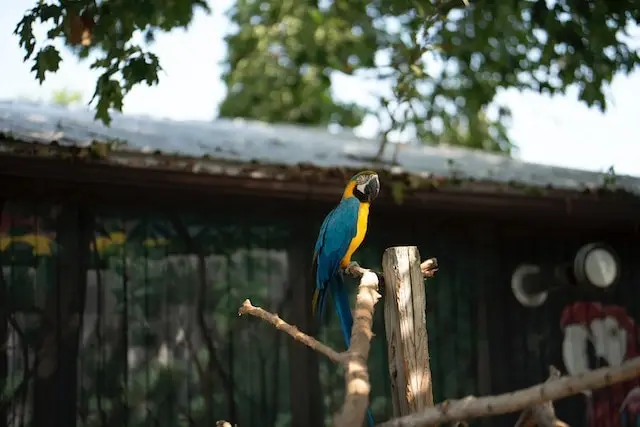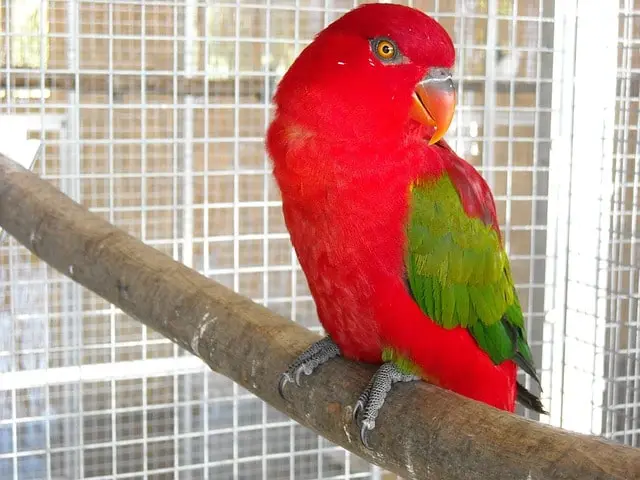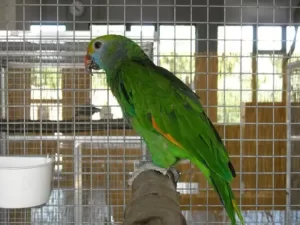Most parrots originate in equatorial regions where the temperatures are hot all year. Because of this, they are able to tolerate heat much better than cold.
However, this is speaking about parrots in the wild. Captive parrots are used to living in controlled environments where the temperatures do not change as often.
While parrots are naturally adapted to living in warm environments, they may not be able to handle sudden changes in temperatures that they cannot escape from. For example, if a parrot is left inside a car, or outside in direct sunlight, it can get overheated pretty quickly.
The parrot may try to regulate its body temperature by panting and holding its wings away from its body, but it may become overwhelming after a point. Anything upwards of 44°C can be too hot for parrots to handle.
Quick Navigation
What Temperature Is Too Hot for Parrots?
Different species of parrots have varying abilities to control their body temperature and tolerate heat in their surroundings. Generally, parrots that are used to experiencing hot weather conditions can stay outside longer. But even then, they can become uncomfortable when the temperatures rise beyond a certain point.
The Journal of experimental biology conducted a study to learn about the upper limits of thermoregulation under hot temperatures in two species of Australian parrots. The study found that the parrots could handle temperatures ranging from 44°C to 55°C before they couldn’t take it anymore.
Captive parrots may have a threshold lower than this, but they can be adjusted to become more tolerant to higher temperatures by exposing them to heat for short periods. However, it also depends on factors such as the age and health of the parrot.
What Is The Best Temperature For Parrots?
The average temperature in tropical regions is between 20 and 29 °C. If the temperatures get warmer, wild parrots know their way to look for shelters and prevent themselves from the heat.
However, parrots raised in captivity rely on their caregivers to maintain ideal temperatures for them. The ideal range of temperature for most parrots is 18°C to 22°C.
Should You Take Your Parrots Outside In Hot Weather?
Letting your parrot get some sunlight can be good for its health. Sunlight helps them get their daily intake of vitamin D. But there are a few things to remember when you take your parrots outside.
Try to pick times when the sun isn’t too hot, like in the morning or late afternoon. This helps them stay comfortable and not get bothered by the heat too much.
However, it is not wise to bring them under direct sunlight as that might harm them. You should keep your parrot under a shade to protect it from UV rays.
If you have an aviary, it is important to keep them in a spot that’s not too hot. Parrots can start to get overheated in direct sunlight, so keeping them away from the sun helps them stay cool.
Summers are the best time to take your parrot outside to get some sun exposure. In the winter, it can be difficult for parrots to get sunlight which does affect their circadian rhythm.
On average, you should let your parrot get sun exposure for around 30 minutes every day. This time helps their bodies take in sufficient vitamin D.
But while they’re out with you, pay attention to their behavior to make sure they’re okay. If they seem uncomfortable or too hot, you should bring them back inside.

Can Parrots Overheat?
Parrots are capable of regulating their body temperature to a certain extent. But when the rising temperatures exceed what they can bear, they can quickly start to become overheated. Overheating occurs when a parrot is unable to cool itself under the current temperature.
There can be various reasons for overheating in parrots. A parrot may get overheated in situations where it is confined to a small space such as its cage in high temperatures.
If your parrot is overweight, it might be at an increased risk of getting overheated as it may keep the heat from escaping its body.
If the parrot is left unattended in such a situation, overheating may be fatal for its health and even lead to death.
Signs That A Parrot Is Overheating
Sudden changes in temperatures are not tolerated well by parrots. Here are the typical signs of overheating to look for:
Holding Its Wings Outward
A parrot that is feeling hot may open up its feather and hold its wings outward. It is kind of similar to how a parrot will fluff up its feathers when feeling cold.
But instead of creating a layer of insulation to trap heat, parrots hold out their wing feathers to let air pass through them and cool them down. You may also notice the wings drooping as the bird feels exhausted by the heat.
Panting
Parrots do not have sweat glands to lose body heat the way we do. Instead, they rely on other mechanisms to dissipate heat.
Panting and open-mouth breathing are two methods by which parrots lose heat. It helps them cool down by making moisture evaporate from their bodies. However, this action uses up a lot of energy and increases their need for food and water.
Hot Feet
If your parrot is starting to overheat, you will notice that its feet are getting hot. You can check if the temperatures are too hot for your parrot by letting it perch on your finger or hand and giving it some water to drink. After the bird drinks the water, you will notice the feet’ temperature cool down.
Less Active Than Normal
For parrots to avoid overheating at high ambient temperatures, they need to spend more energy in respiration and evaporation. This not only drains their body of fluids but also makes them lethargic.
Erratic Movements
Once the parrot is no longer able to bear the hot temperatures, it may start to act restless and erratic. Some birds may even show sudden aggression and agitation in hot weather.
How To Keep Your Parrot Cool In Hot Weather?
Parrots are subject to overheating in high temperatures which can lead to heatstroke, and dehydration among other problems. So it is our job to keep the heat down in the surroundings and help our parrots stay cool and relaxed.

Provide Plenty Of Cool Water
As more water is lost from the body through evaporation cooling, the water requirements for parrots in hot weather go up. Parrots need more water in hot weather to stay well hydrated.
You should make an effort to replace the water in their bowls regularly. If the water in their bowl gets warm, the parrot may not be willing to drink which may lead to dehydration faster.
Bathing And Misting
On hot summer days, parrots can get quite uncomfortable. The high temperatures can increase their body heat, making them use more energy, and also cause dry and itchy skin.
An aloe bath or light misting with cool water can be very relaxing and soothing for your parrot and help in maintaining optimal body temperatures.
You can either mist them using a spray bottle or offer them a bowl of water to bathe themselves.
Usually, bathing 3-4 times a week is sufficient, but if you live in a region with low humidity, you should provide more frequent baths.
Air Conditioners
Pet parrots are acclimated to the air conditioning indoors and may feel more comfortable in cool temperatures during the summer. You do not need to take your parrots outside for long when it’s hot. Captive parrots prefer the comfy temperatures indoors since they are raised in it.
Shade
Whenever you’re planning to take your parrots outside to get exposure to sunlight, make sure you provide them with shade. You should not put them under raw sunlight. You should also avoid taking them out during the afternoon when the sun is at its hottest.
For parrots in an aviary, it is a good idea to keep them in a comfy spot that is not under the scorching heat of the sun. Heat strokes and overheating are one of the biggest causes of death of aviary birds
Weight Loss
If your bird is overweight, it does not help it in coping with excess heat. The layers of fat in the parrot’s body can be a barrier to heat loss and restrict its thermoreulation abilities.
It’s important that you help your parrot maintain a healthy weight, especially during hot weather. You shouldn’t necessarily adjust the amount of food you give them because they spend more energy on warmer days. However, you should evaluate your food choices for them.
Avoid giving them seeds as they are high in fat and focus more on leafy vegetables and fruits. Offer them lots of watery fruits such as watermelon, strawberries, grapes, etc.







